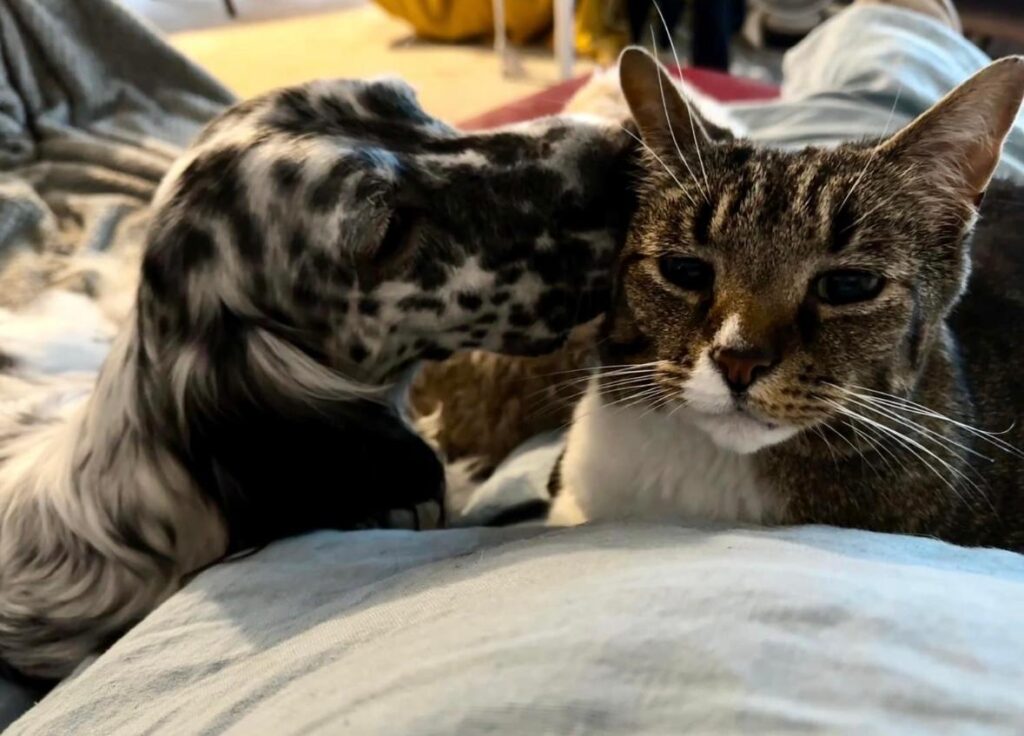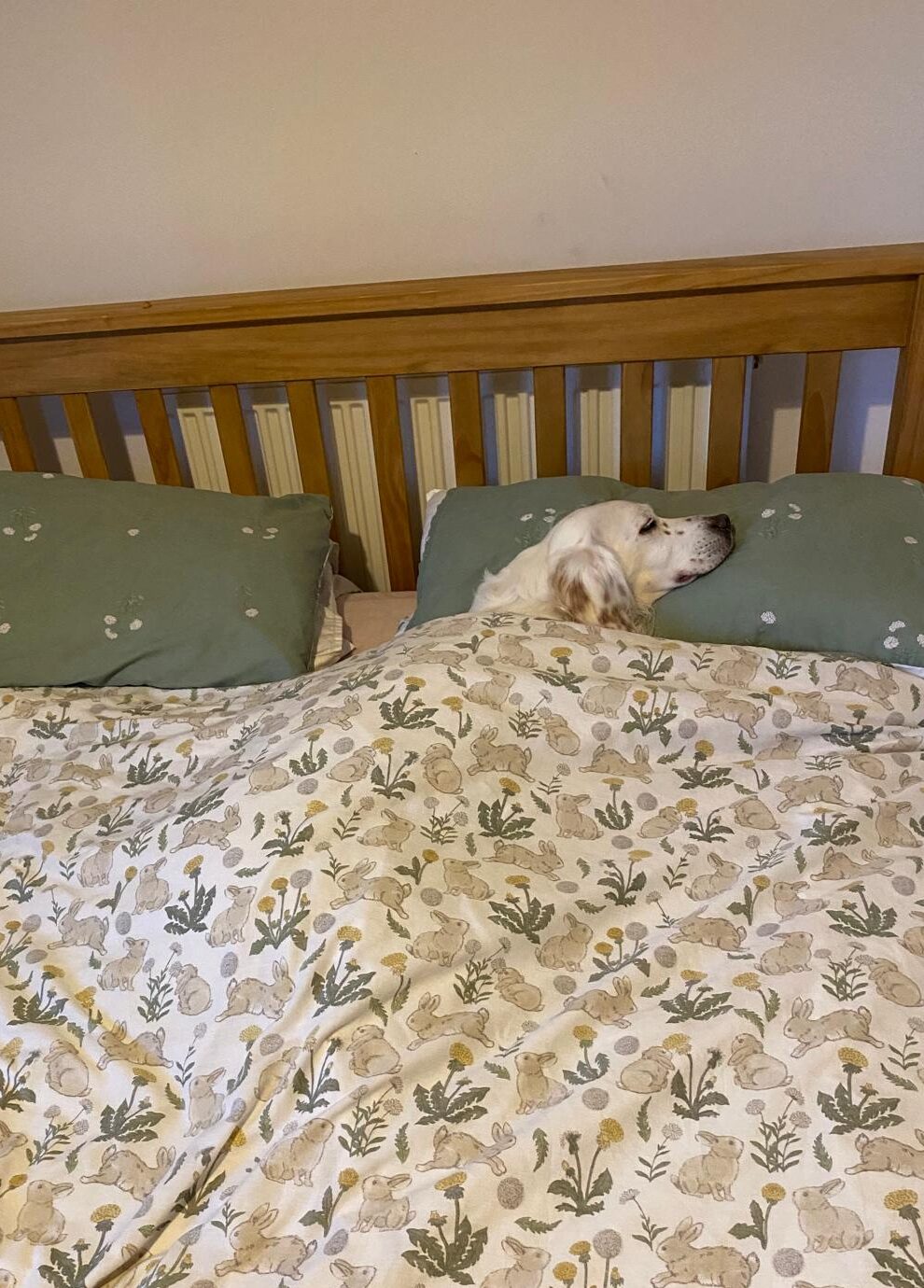The dogs we rehome will have never lived with cats (or other small animals) before and, with their high prey drive, they can sometimes find it difficult to control themselves – resulting in cats being barked at and chased.
Although we can cat test any dog that is going to a home with a resident cat, those tests are in a very different environment to your home and are generally done with a cat that is used to dogs so don’t necessarily show exactly how your new dog will react.
The key to your cats and dogs living harmoniously is preparation. You also need to be realistic about what your aim is – everyone would love to see their cat and dog snuggled up together on the sofa but the real-life approach should be to get your animals coexisting under the same roof.
So, even if your cat is dog savvy and your new dog passed the cat test with flying colours, we would recommend following these steps:
Before the dog arrives
There are a few things you can do, in advance, to prepare yourself, your home and your cat for the arrival of your new dog
Setting up a Feliway diffuser (plug in ones are available at pet stores and online) can help some cats, particularly those more nervous ones. The diffusers work by giving off pheromones which can make the cat feel more relaxed. Aim to do this about a week before the new arrival for the best effect.
Identify a safe space for your cat, somewhere they can easily get to that the dog can’t access. Make sure that all the essentials like food, water, litter tray etc are available to them in, or from, that space.
Baby/stair gates are a useful tool to separate an area or make upstairs the cat zone. Just make sure that it’s high enough that the dog cannot easily jump it but easy enough for the cat to get past – if you have an older cat, maybe think about a stair gate with a built-in cat flap, or leaving a cat size gap at the bottom.
Make as many of these changes in advance of the dog arriving so your cat can get comfortable with the new arrangements.
When your dog is here
In the early days, it’s important to keep the cats and dogs separate and to avoid confrontations and chasing. Many dogs will see a cat and be confused by it, leading to barking so try to keep each animal in their designated ‘zone’ in the house. This may mean closing the dog in one room whilst the cat makes its way outside, doing a recce of the garden before allowing the dog out and changing feeding times so that the cat can eat in peace.
If you have a dog savvy cat, one that is used to living with dogs, it can actually feel more difficult to manage as the cat will assume that the new dog is like all the other dogs it has known and is friendly.
Use these first days to start to acclimatise them both to the idea of the new family member. You can start to do this by introducing them to each other’s smells by swapping bedding and blankets and simply moving from one to another without washing hands or changing clothes. Both cats and dogs rely heavily on scent so this can be a very important step.
Introductions
Once your dog has settled in a bit and started to relax, you can start to think about the first introductions.
Where the introduction takes place will depend upon the layout of your house, but make sure that the cat has an easy route back to their safe space and/or to outside. If your dog gets excited easily, then first introductions are best carried out after exercise or some enrichment activity, when your dog is likely to be calm.
One of the most important rules of introducing cats and dogs is to make sure that the dog can’t chase the cat. Even if your dog doesn’t want to hurt your cat, your cat will feel threatened and is unlikely to want to be anywhere near your dog in future! Once a dog develops a habit of chasing, it can be difficult for you to stop them, so it is best to prevent it from happening in the first place.
Put your dog on a lead behind a stair gate and have some tasty treats on hand to reward them for calm and relaxed behaviour. At this point it can be useful to have someone else around to help. Whilst distracting your dog (with some training or treats), allow your cat to see your dog and approach if they want to. Most cats like to spend time watching (often from above!) and will take their time to decide whether it’s safe to approach or not. It’s important that they are allowed to do this in their own time, so don’t force your cat closer – you may get seriously scratched or bitten if they panic.
Your dog is probably going to show some interest at this stage but in what way will depend on the dog. If they become overly excited and begin to bark, then you can move them further away and use some food to distract them. Looking at the cat for short periods is fine, but if they stare for too long, use food to interrupt. Don’t forget to praise and treat your dog for behaving well.
Keep these initial interactions short at first and try to end on a positive note.
Repeat this over several sessions until your dog learns to look at you for a treat when they see the cat. Training sessions (of all types) should be little and often and remember to keep your dog on a lead at all times. If it doesn’t go well, go back a few steps, continue scent swapping and try again the next day. Ideally, the dog will learn to like the cat and stay calm as it represents a positive reward and the cat will become more confident too. Once this behaviour is learned, the treats and lead should no longer be needed or you could replace them with a lower value reward like a toy.
As things progress, you can let the cat and dog interact more freely but, until you are 100% confident in their relationship, it’s really important not to leave the dog and cat unattended together.
If you feel it would be helpful, you can use a houseline (a lightweight lead without a handle that can easily be grabbed or stepped on if you need to take control) to prevent any chasing.




